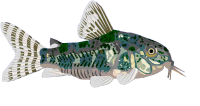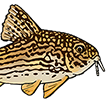NEED AN ID ON THIS PLECO.
Re: NEED AN ID ON THIS PLECO.
Problem is one of a commercial nature.The fisherman is setting a very high price.I have to determine if the fish is worth it, which is why I am trying to find out through this forum which has some of the best catfish experts in the world. Then, you have to have enough people who can pay the price for it after we figure out what it is.
I have seen many fish that are common and cheap in one country be stupid expensive in another where they also are newly discovered.If this is a $40 fish in Brasil and another race is secreted in a river up in Peru...that does not make it worth 4 figures in price.
Here are another 2 from Peru.One is a new perkoltia-the biggest I have ever seen and came in collected with a loricaria we have never seen before that had yellow pectoral fins.The second is what we call the red zebra and pictures do not do the red color through the whole fish any justice.I am trying to get those collected again.
I have seen many fish that are common and cheap in one country be stupid expensive in another where they also are newly discovered.If this is a $40 fish in Brasil and another race is secreted in a river up in Peru...that does not make it worth 4 figures in price.
Here are another 2 from Peru.One is a new perkoltia-the biggest I have ever seen and came in collected with a loricaria we have never seen before that had yellow pectoral fins.The second is what we call the red zebra and pictures do not do the red color through the whole fish any justice.I am trying to get those collected again.
- racoll
- Posts: 5258
- Joined: 26 Jan 2004, 12:18
- My articles: 6
- My images: 181
- My catfish: 2
- My cats species list: 2 (i:2, k:0)
- My aquaria list: 1 (i:0)
- Spotted: 238
- Location 1: London
- Location 2: UK
Re: NEED AN ID ON THIS PLECO.
Regarding the fishes in your last post eczs-1, fish number two and three are certainly not . They are both .
Fish two looks very similar to , while fish three looks more gracile, but again similar to and perhaps . I can't remember a name for it at the moment though.

Fish two looks very similar to , while fish three looks more gracile, but again similar to and perhaps . I can't remember a name for it at the moment though.
- HaakonH
- Posts: 404
- Joined: 06 Jan 2005, 11:32
- My articles: 2
- My images: 376
- My catfish: 1
- Spotted: 232
- Location 1: Bergen, Norway
- Location 2: Bergen, Norway
- Interests: Fish fish fish!
- Contact:
Re: NEED AN ID ON THIS PLECO.
eczs-1,
That yellow-finned one is a Lamontichthys species, possibly L.filamentosus which appears to have a yellow sheen in it's fins.
Regarding the new little fish, how about if you tell your fisherman that it seems like the species in question hails from Xingu? Not that this may necessarily be the only correct place of origin, although it does seem likely, but if you present some facts to him then maybe he will provide you with a little more info...? The easiest way to proove that they are from Yavari would be to go get some more evidence material and document it with photos ;)
I still stick to my belief of it being a Hypancistrus species until that can be excluded based on it's teeth. I have seen some almost unicoloured white Hypancistrus sp.cf.zebra, but if these and the one in question are all the same species isn't easy to say...fins look alike but bodypattern doesn't. I wish we could see several specimens next to each other, that would make it more likely that this is indeed a strain occuring in significant numbers
-Haakon
That yellow-finned one is a Lamontichthys species, possibly L.filamentosus which appears to have a yellow sheen in it's fins.
Regarding the new little fish, how about if you tell your fisherman that it seems like the species in question hails from Xingu? Not that this may necessarily be the only correct place of origin, although it does seem likely, but if you present some facts to him then maybe he will provide you with a little more info...? The easiest way to proove that they are from Yavari would be to go get some more evidence material and document it with photos ;)
I still stick to my belief of it being a Hypancistrus species until that can be excluded based on it's teeth. I have seen some almost unicoloured white Hypancistrus sp.cf.zebra, but if these and the one in question are all the same species isn't easy to say...fins look alike but bodypattern doesn't. I wish we could see several specimens next to each other, that would make it more likely that this is indeed a strain occuring in significant numbers
-Haakon
- Janne
- Expert
- Posts: 1765
- Joined: 01 Jan 2003, 02:16
- My articles: 10
- My images: 241
- Spotted: 73
- Location 2: Belém, Brazil
- Contact:
Re: NEED AN ID ON THIS PLECO.
eczs-1,
I still think this species comes from Rio xingu and are smuggled to Peru with many others, the distance between these 2 rivers is far more than 700 miles but there is a regulare trade from xingu (Altamira) to Leticia and than Peru... if you trust your fishermen this is from Rio yavari and if you dont trust them its from Rio xingu. It would be a sensation if they find any Hypancistrus species in Peru, most rivers is very poor investigated when it comes to species living little deeper than a few meters so it's not completely impossible.
Janne
I still think this species comes from Rio xingu and are smuggled to Peru with many others, the distance between these 2 rivers is far more than 700 miles but there is a regulare trade from xingu (Altamira) to Leticia and than Peru... if you trust your fishermen this is from Rio yavari and if you dont trust them its from Rio xingu. It would be a sensation if they find any Hypancistrus species in Peru, most rivers is very poor investigated when it comes to species living little deeper than a few meters so it's not completely impossible.
Janne
- Suckermouth
- Posts: 1609
- Joined: 28 Nov 2003, 14:29
- My images: 17
- My cats species list: 22 (i:0, k:0)
- My aquaria list: 2 (i:0)
- My BLogs: 6 (i:0, p:165)
- Spotted: 14
- Location 1: USA
- Location 2: Washington, DC
Re: NEED AN ID ON THIS PLECO.
That Lamontichthys is probably L. stibaros based on being from Peru. L. filamentosus can also be found in peru, but it should also have longer filaments from its fins, although of course those could have been damaged. That's my guess, anyway.
- Milton Tan
Research Scientist @ Illinois Natural History Survey
Research Scientist @ Illinois Natural History Survey








/g/s/1.jpg)